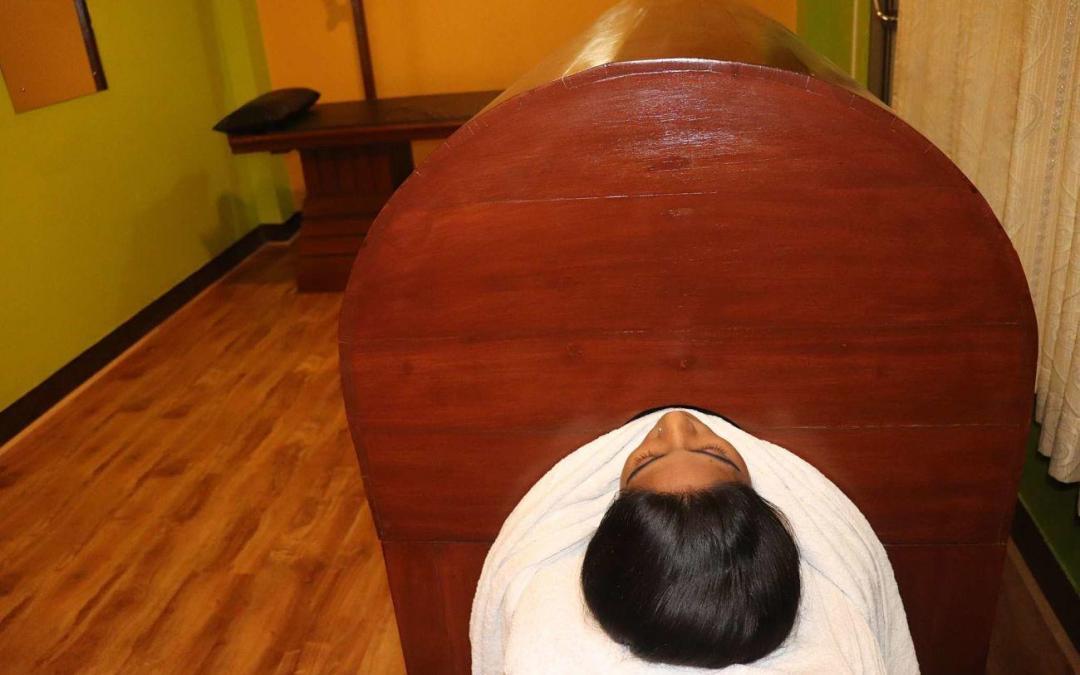Swedana in Ayurveda | Steam Bath Therapy
Swedana (heating of body/sudation) is a treatment therapy of Ayurveda clinical practice. The word Sweda is derived from Sanskrit swid, meaning ‘to sweat or to perspire’. It is practiced either as a purvakarma (preparatory therapy) to Panchakarma or as an independent therapy. It is usually given after oleation – Snehana therapy.
How does swedana function?
Swedana occupies a major part of the practical therapies of Ayurveda and is praised for its relaxing and detoxifying effects. Swedana drugs by Ushna and Tikshna guna are capable of penetrating the microcirculatory channels (Srotas) where they activate the sweat glands to produce more sweat.
By Swedana, due to arterial dilatation, the part gets more circulation. That causes the displacement of exudates hence relieve pain, relaxes muscular spasm. Sweda karma maintains the thermoregulation system of the body by maintaining equilibrium between core temperature (temp. inside the body) and shell temperature (skin temp.)
Sweda karma hastens this process by increasing the permeability of capillary and bringing the morbidities into an extracellular fluid by dilating and clearing the channels of the body. It then liquefies the vitiated Doshas inside the body (which are already made soft by oleation, later to be brought to Koshtha, which will be eliminated by inducing either Vamana / Virechana.
Types of swedana
There are two basic methods of Swedana, one is Niragni, which represents the method where the body is warmed without getting heated directly. For example, exercise, use of blankets, etc. Another is Saagni, and it utilizes various methods of applying dry or moist heat directly upon the body to make it warm. For example, Baluka Sweda, Pinda Sweda, Nadi Sweda.
Nadi sweda
Nadi sweda is the most common type of sudation performed in Ayurveda therapies. The word Nadi refers to hollow pipe. In this procedure decoction of Vata and Kapha alleviating plants is prepared in a closed vessel with a single outlet. A hollow pipe is fitted in this outlet such that the steam coming out of the vessel can be directed through this pipe to the receiver’s body.
Pinda sweda
is a widely practised swedana procedure where the treatment principle is based on combined effect of heat and medicament. In pinda sweda, we use a bolus or a spherical object that is heated, and the heat is transferred to the body.
Based on the Guna (properties) of the Dravya used for the Swedana karma is of three types Snigdha Ruksha, Snigdha, Ruksha for Vata-Kapha, Vata and Kapha respectively. So, one can classify Pinda Sweda according to the Guna of Dravya used.
Baluka Sweda
Baluka sweda is the classical name for sand sudation. The Baluka (sand) is heated and tied into pottalis (bags) which are applied on boy parts directly after providing some oleation on those body parts. It relieves pain and inflammation and commonly used locally in Sandhigata vata(osteoarthritis), Amavata(rheumatoid arthritis) etc. This is very useful in alleviating vata and kapha diseases and pain all over body.
Shashtika shali pinda sweda
Shashtika Shali (rice harvested in 60 days) Pinda Sweda is performed in over the whole body or locally on a specific part with the bolus of boiled Shashtika shali with Balamoola kwatha (Decoction of roots of Bala) and Ksheera (milk). This is a unique type of sweana as it is given with purpose of strengthening the body.
Patra pinda sweda
The word “Patra Pinda” is made of two words, Patra means leaves and Pinda means bundle. Patra pinda Sweda refers to the Swedana performed using a bundle of Vata Kapha alleviating Patra
How Swedana Benefits
- Balances Vata and Kapha humors in the body
- Detaches toxins; expels them through the tiny pores of the skin along with sweat
- Increases circulation; reduces inflammation
- Revitalizes and rejuvenates the skin
- Improves digestion
- Removes stupor
- Acts on fat tissues
- Relieves stress
- Eases sore muscles
- Reduces numbness, stiffness, rigidity, heaviness; improves mobility.
Indications
- Hemiplegia
- Arthritis
- Parkinsonism
- Motor Neuron Disorders
- Osteoarthritis
- Low back ache
- Sciatica
- Asthma and cough
- Sinusitis
- Chronic constipation
